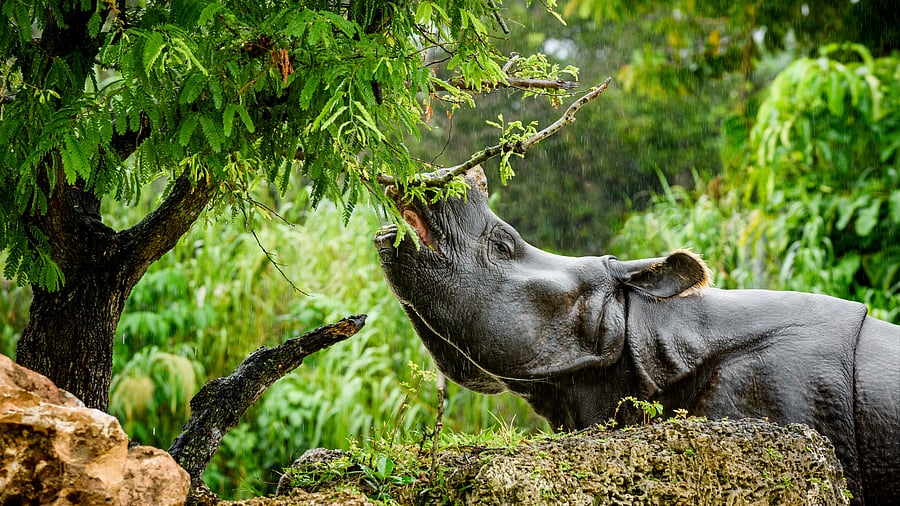
Representative image showing a rhino
Credit: iStock Photo
Recently, an out-of-the-box attempt to save rhinos from poachers made headlines. Scientists at the University of the Witwatersrand, South Africa, launched an anti-poaching campaign where the horns of rhinos would be injected with radioactive material. While this is harmless to the animal, it will deter poachers from moving poached horns because detectors at airports, seaports, etc. would detect radioactive material.
Around the world, there are five species of rhinos; two are found in Africa, and three in Asia — all five face a major challenge from poaching. Poaching is an international crisis, and various approaches are being employed, yielding varied results.
In South Africa it is legal
For more than a decade now, this author has been closely following the upsurge in rhino poaching incidents in a few African countries. Africa has lost over 8,500 rhinos in the past decade. Such huge numbers show a protection system where conservation, wildlife management, and law enforcement all need vast improvement. Key to this is a strong-willed government and proactive conservation voices from civil society and local communities.
A reason why rhino poaching is still rampant in parts of Africa is that strong laws, and their enforcement are lacking. Then there is South Africa — where the domestic trade of rhino horn is legal! Also, there has been a long-standing demand from rhino farmers to legalise rhino horn trading. As of 2020, when the last official stockpile figures came, South Africa had close to 75,000 kg of rhino horns, 47,545 kg of it in private hands! The sale, legal or illegal, to China or Vietnam (where there is a demand for rhino horns) will only trigger further demand.
India as an example
When we talk about the conservation of the greater one-horned rhino in India, Assam emerges as the state with the largest wild population of greater one-horned rhino, followed by West Bengal and Uttar Pradesh. Currently, Assam has about 2,885 rhinos, while West Bengal has about 392, and Uttar Pradesh has about 46.
In the subcontinent, the greater one-horned rhino is found in India and Nepal, and, in recent years, both countries have been successful in drastically reducing the number of poaching incidents.
Assam witnessed the highest rhino poaching in 2013 when it lost 41 rhinos. Since then, the state government has taken a series of efforts to strengthen protection efforts by doubling the size of frontline forest staff in Kaziranga National Park, which holds about 65% of the global wild population of greater one-horned rhinos.
Assam has provided semi-automatic weapons to the forest protection force to fight poachers. It has also engaged the Assam Police’s special task force to check rhino poaching. As a result of such combined efforts, 2022 saw no rhino poaching, and 2023 and 2024 saw two rhinos killed each year. Reducing rhino poaching numbers from 41 in 2013 to just two over a decade reflects that the measures adopted by the state government have yielded results.
In addition to beefing up the police force, fast-track courts were set up to deal with wildlife offences. In an epochal move, in 2021, on World Rhino Day (September 22), to send a global message that rhino horn has no medicinal value, the Assam government burnt about 2,479 rhino horns kept in its treasuries.
If India has been at the forefront of protecting rhinos, it is because of a strong political will shared by the successive governments. A strong commitment triggers strong law enforcement and further strengthens vigilance and protection efficacy.
This is where India’s story is different from wildlife conservation efforts in Africa.
Conclusion
Radioactive tagging, as mentioned in the beginning, might be a novel approach — but India and Nepal have proved that there is a better alternative, one where the animal is not captured or immobilised. The environment around the rhino needs to be protected, with laws enforced. India and Nepal need to focus on consolidating the protection efficacy. South Africa and other nations should first frame an unambiguous philosophy when it comes to protecting the rhino—thoughts about legalising rhino horn trade or selling horns to ‘raise money and awareness’ are an avoidable rabbit hole. These countries can also learn from India’s and Nepal’s success stories.
Bibhab Kumar Talukdar, a renowned rhino conservationist, is founder and secretary general, Aaranyak.
Disclaimer: The views expressed above are the author's own. They do not necessarily reflect the views of DH.